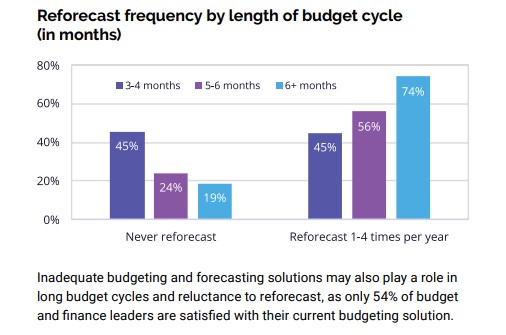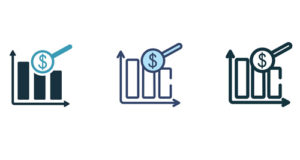Higher education can’t catch a break these days. Institutions are dubbed “glorified Skype” for switching to virtual-only models, featured in the news almost daily for reporting more COVID-19 cases on campus, and told sending students home is “the worst thing you can do.”
Colleges and universities also continue to face criticism over costs at a time when their financial woes are worsening: operating expenses increased 10 percent during the pandemic, lucrative international enrollments declined, and auxiliary revenue such as room and board dropped.
It’s an environment that forces finance leaders to rethink their institution’s business model, including the way in which they budget.
The business case for reforecasting
Administrators can no longer afford inefficient planning processes — they must do more with less by streamlining budget processes and reallocating resources based on emerging goals. Reforecasting can help.
Related content: 4 higher-ed predictions for 2021
Reforecasting involves reassessing the budget at regular intervals — typically, one to four times a year — and making changes to the budget based on current trends and activity.
A survey found that 74 percent of institutions whose budgeting cycles last longer than six months reforecast one to four times a year. That’s important because the data used during long budgeting cycles can quickly become outdated. Without reforecasting, institutions with long budgeting cycles struggle to react to changing needs — which are ever-present during this pandemic.
But frequent reforecasting has been slow to take off in many college and universities — one in five institutions with long budgeting cycles do not reforecast at all. Three reasons stand out:
• Cultural barriers. Because institutions spend so much time preparing their budgets, there is a sense that the budget is monolithic. As a result, leaders typically do not want to touch it again.
• Inadequate budgeting and forecasting solutions leave leaders reluctant to reforecast. Only one-half of higher education institutions have budgeting and reforecasting software they are satisfied with (54 percent). Without the right tools, the budgeting process is prolonged and difficult to adjust to fit the institution’s changing needs.
• Reforecasting adds even more work to finance teams. Budgeting cycles in higher education are trending longer: 43 percent of institutions spend more than six months on budgeting, compared with 38 percent in 2019 and 34 percent in 2018. Given the amount of effort that goes into these cycles, the idea of digging back into an institution’s assumptions at regular intervals can be a hard pill to swallow.
EXHIBIT ONE:

Source: Higher Education Financial Trends: Priorities, Challenges, and Insights to Get Ahead in 2020, Syntellis Performance Solutions, 2020.
But resistance to reforecasting can hamper data-based decision-making as financial conditions change. It’s a scenario that holds true during the pandemic and in a less volatile economy.
The right tools for reforecasting and recovery
Equipping finance teams with the proper tools for budgeting, reforecasting, and financial planning empowers them to navigate COVID-19 recovery with agility, and to support the institution’s long-term financial plans and goals.
Among higher education institutions with adequate budgeting and financial planning solutions, finance teams report improved accuracy and data integrity, and stronger collaboration institution-wide. Reporting becomes easier, and budgeting takes less time.
In institutions where three-quarters of revenue or more comes from tuition, reforecasting two to three times per year provides a good basis for decision-making. Larger universities and those with more revenue sources can benefit from more frequent forecasts.
The right tools can ease the transition to reforecasting and offer valuable financial insights beyond the operating budget. Here are five ways to get started.
No. 1: Replace spreadsheets with a system that standardizes data, calculations, and reporting. Replacing spreadsheets with a budgeting or planning tool ensures a level of insight and transparency that can’t exist when data is disparate and not well-managed.
No. 2: Automate the budget process. This enables finance teams to budget faster and spend more time on high-value strategic analysis.
No. 3: Complete budget variance reporting. This gives finance teams more time for analysis and reduces time spent on subsequent forecasts.
No. 4: Integrate enrollment, human resources, and general ledger data with financial data. This empowers finance teams to assess the financial impact of real-time enrollment and staffing numbers and respond to protect the institution’s financial health.
No. 5: Strengthen stakeholder engagement throughout budgeting and reforecasting. Leading institutions engage key stakeholders through dashboards and highly visual reports, widely sharing progress toward meeting targets for long- and short-term initiatives. When performance falls below expectations, leaders investigate what went wrong, make modifications, or deploy exit strategies — all guided by data.
A modern budgeting approach
Making mission-critical decisions for higher education in a volatile environment depends on timely data, modern budgeting processes and tools, and stakeholder engagement.
Before the pandemic, 65 percent of higher education finance leaders were only somewhat confident in their institution’s ability to respond with agility to sudden changes in business circumstances.
EXHIBIT TWO:

Source: Higher Education Financial Trends: Priorities, Challenges, and Insights to Get Ahead in 2020, Syntellis Performance Solutions, 2020.
Now, the ability to demonstrate and strengthen an institution’s value proposition depends on having tools and the data to adapt quickly when circumstances change. Embracing the move to reforecasting, supported by modern budgeting and financial planning tools, will better position finance leaders to support institutional success, now and in the years to come.
- What your institution gets when you give - January 2, 2025
- Defining AI policy in teaching and learning - December 31, 2024
- Is AI education’s holy grail, or are we on the wrong quest? - December 30, 2024
